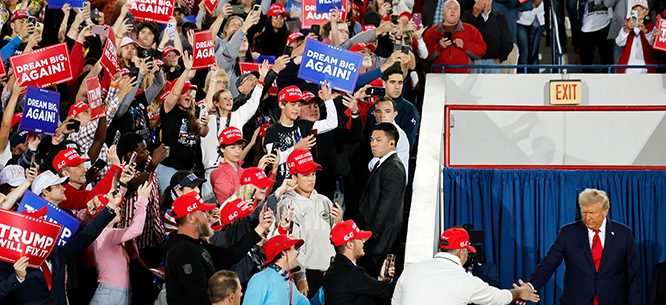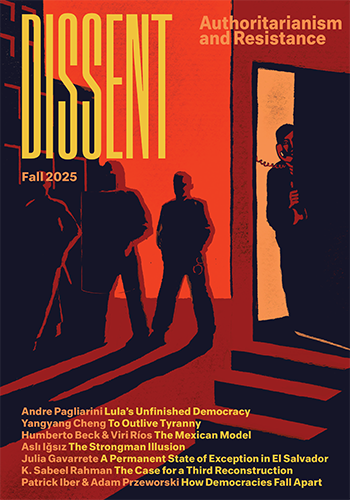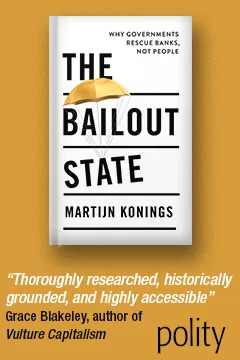A Fractured Coalition
A Fractured Coalition
A roundtable on the 2024 election.

This conversation took place on November 14, 2024. It has been condensed and edited for clarity.
Patrick Iber: Let’s start where AOC started a few days after the election. On Instagram, she asked people who had voted both for her and for Donald Trump to explain themselves. The answers were various. Some people mentioned Gaza. Others said things like, “You are focused on the real issues people care about”; “Trump and you care for the working class”; “I feel like Trump and you are both real”; “Voted Trump but I like you and Bernie.” What do we make of this cluster of justifications?
Aziz Rana: There’s an established way of thinking and talking about politics that’s shaped the center-right and the center-left for decades. It’s associated with the Cold War liberalism of both Barack Obama and George W. Bush. When they talk about the United States and the world, their vision assumes the basic justness of existing institutions. The country is exceptional because it is grounded in a project of equal liberty for all. This means that whether it’s market capitalism or issues of race, things are essentially proceeding as they should, and we only need small incremental reform. And globally, the United States rightly enjoys a robust authority to intervene wherever it deems necessary, and its national security elites are effective guardians of collective security and freedom.
For twenty-plus years, Americans have been experiencing a set of rolling social crises—and related political developments—that have undermined faith in every element of that vision. These include the “forever wars” in Iraq and Afghanistan (along with Gaza and Lebanon today), the financial crisis, the Movement for Black Lives, the rise of both Trump and Bernie Sanders, the pandemic, and more. As a result, political life now is much more fractured than in 2000 or 2008, and you see the emergence of unexpected ideological formations. I think it’s a mistake therefore to view Trump’s victory as a decisive and lasting move of the country to the right, even with the relatively larger support he garnered from minority communities. Given how unpopular incumbents are everywhere around the world, and the weaknesses of Joe Biden in this election cycle, Trump may well have underperformed. He is likely to end up with less than 50 percent of the vote and win by a historically narrow 1.6 percent in the popular tally. Above all, it seems that the center—of any stripe—is having a harder time holding. The right was structurally situated to take advantage of that fact.
Tressie McMillan Cottom: I could not agree more. I don’t think these strange ideological bedfellows are that strange. They are only strange to the extent that we—and by “we” I mean the media, academia, talking heads, politicos—have refused to take Trump’s rhetoric literally or figuratively, or accurately in either case. If you are a voter listening to Trump and you don’t have professional class hang-ups, you can say, “I am quite capable of knowing that Trump is speaking figuratively sometimes, but when he speaks literally, he is the only person speaking to what I think are the important issues.” I’ve been hearing this from voters for several years.
Some of that is wrapped up in how people think about economics, but it’s also about the long, slow-rolling crisis of social reproduction costs being shifted from the state to families and to individuals, with absolutely no political acknowledgment that it is happening. Regular people are talking about inflation, but they’re also really talking about wages, child-care costs, divisions of labor, and how unsustainable all of that is.
We have a long-standing idea of what a Black voter is, or what a Latino voter is, or what a woman voter is. I think we’re seeing some softening of that understanding. There is not a cohesive Black social institution or social infrastructure at this point that is strong enough to define a monolithic Black vote. Membership in the Black church is declining, which is one of the reasons why there wasn’t a ton of campaigning happening directly in Black churches this year. A lot of that attention is shifting to barber shops instead. There has been a complete decimation of Black geographies across this country.
This has pushed people into discursive spaces where they are overexposed to something that Trump is very good at: manipulating media to create alternative realities. If being Black or being Latino is something that you do on social media, well, social media’s also the place where Trump is really good. It’s also a place where AOC is really good. They are using the same tools to create a message about the fracturing and splintering of identity politics in a way that is cohesive for many people.
Alyssa Battistoni: There was a similar conversation in 2020 around Florida voting for Trump but also for the $15 minimum wage, even though Biden supposedly supported a $15 minimum wage and Trump didn’t—or this year with people who voted for abortion access at the state level but also voted for Trump.
We shouldn’t be surprised that there are seemingly contradictory configurations among voters who want change. I don’t think it’s a new phenomenon, I don’t think it’s as contradictory as it might seem, and I don’t think it’s even irrational in some cases. Voters who are dissatisfied with the status quo and who distrust the political establishment are skeptical of the usual politician pablum; they’re looking for someone who seems like a real person and who speaks to the things they’re concerned about. They’re not necessarily choosing a candidate by ticking off a list of policies from the campaign website. Some of these people might have supported someone like Sanders or AOC, but they might also vote for Trump even if they don’t agree with everything in Trump’s policy platform. They might disagree with Republicans on abortion or the minimum wage, but also ask, “What are Democrats doing about abortion? Where is the $15 minimum wage?”
Timothy Shenk: There’s a lot of continuity between the AOC–Trump voter in 2024 and the Bernie–Trump voters from 2016, or the Obama–Trump voters from the same. year. We can go back much earlier, too. There really were people in 1968, for instance, who were torn between RFK and George Wallace. In all these examples, casting yourself as an anti-establishment outsider appealed to a certain slice of the electorate. In 2024, when the percentage of Americans who think the country is on the right track has been under water for more or less twenty years, there’s a natural constituency for anti-incumbent, insurgent politics, for reasons connected to the deep structural story that Aziz and Tressie told.
But how to move from this structural analysis to building an electoral coalition is a tricky question. In 2016, I thought the anti-establishment mood opened these voters up to radical politics of all kinds. With the benefit of hindsight, I think I underestimated the work that Trump did—and continued to do in this campaign—to win over swing voters. On reproductive rights, for example, coming out against a federal abortion ban was part of a strategy to reduce the salience of abortion so that pro-choice voters in Michigan or Pennsylvania could tell themselves, “I’m not happy that Roe v. Wade was overturned, but Trump says it’s a state issue now, so I can vote on the economy or immigration.” It’s the same reason he keeps saying he won’t touch Social Security or Medicare. This was all part of the strategy to build up support with voters who are open to populist economics but more moderate or conservative on social issues. If Republicans are reaching out actively to this group—and they are—the left needs a compelling response.
Iber: For a long time, the intellectual critique of neoliberalism was a leftist project. But anti-neoliberal thought has gained space within the Republican Party. There are still plenty of tried and true neoliberals in the Republican coalition, but both parties have something like a social democratic minority, even if it’s a reactionary and chauvinistic version on the right. What is the right intellectual and political response to this problem? How do we ensure that anti-establishment voters support a progressive version of these ideas?
Battistoni: It’s less clear to me that there is a real social democratic position on the right. There’s a lot of rhetoric about the family, for instance, but Republicans aren’t saying they’re actually going to do anything to make child care more affordable, and more generally there’s no real plan for investing in social welfare programs of the sort we’d typically associate with social democracy. Similarly, there’s some rhetoric about a combination of social conservatism with more left economic positions, but I really don’t see a lot of evidence that this position is being put into practice in any meaningful way by the Republican Party, let alone becoming a significant formation. There is a new critique of neoliberalism from the right, but the self-styled right populists tend to support anti-worker and anti-union policies. In some ways, we are moving out of the neoliberal order, at least in the sense of moving away from globalization, and toward a retrenchment of economic nationalism—including the return of great-power conflict in recent years. But I don’t think a new order is being forged in any stable way; it seems like we’re just careening away from this previous model.
Bidenomics was originally touted as a break with neoliberalism—and some elements do break with that globalization-oriented model, insofar as they are rooted in economic nationalism and often articulated in terms of decoupling from, and competing with, China. But many of the mechanisms in the Inflation Reduction Act, for example—tax breaks, subsidies, and stimulus for private investment—are not very different from those of, say, Obama’s support for solar energy in the post-2008 stimulus bill. There wasn’t a major program of social investment that could address more immediate cost-of-living issues and build a New Deal–like Democratic coalition—though admittedly it seems like Biden initially hoped that Build Back Better could be something closer to that model. The rise of economic nationalism and aggressive anti-China rhetoric is extremely concerning, and we need to combat it from the left. But I don’t think either the Republicans or the Democrats have offered a major break from neoliberalism in practice.
Iber: The right would probably say that their immigration restrictions and tariffs are designed to create a system that is friendlier to working people within this country.
Shenk: Instead of saying Republicans are offering social democracy lite, it would be better to think of it as capitalism with Trumpian characteristics: broad-based economic growth that delivers for both Elon Musk and the working class. It’s not a milquetoast version of the left’s program; it’s a distinctive agenda on its own. In this vision, people won’t have to worry about affording child care, because they’ll be earning enough to pay the bills from their job, and it’ll be a job they can perform with dignity. Americans would get the benefits we associate with the New Deal order, just not through the means we would like.
McMillan Cottom: I think people believe that they are returning to a New Deal social welfare state, but what is actually being promised, if not by Trump then absolutely by J.D. Vance—and Vance seems to have a more stable political identity—is a return to taxpayer citizenship for a subset of Americans, which is actually the 1950s deal. In this model, there is social welfare and a safety net for Americans as they define them. This vision is centered around white men, but it will have some trickle-down effects, which is why it appeals to so many women and to a multiracial, diverse coalition. But who is really included in taxpayer citizenship? The right is not trying to offer the left’s idea of a social safety net; they are taking advantage of the desire for it. To say that there is a social democratic minority in both parties misunderstands what the right is asking of the state, who they want to include, and who they want to exclude.
Rana: I doubt that the right will generate the type of economic populism that they are articulating. Money plays such a central role in U.S. elections. Just look at how the 2024 campaign highlighted the structural conflicts between the Democratic donor class and the Democratic Party’s base. I would not be surprised if similar structural problems that exist in the Republican Party reappear. It’s all well and good for them to take an economic nationalist approach, but if that is wedded to a predatory, crony capitalism in which the party provides giveaways to the richest people within their coalition, it’s hard to see that as the basis for a genuine and lasting realignment. I think it’s much more likely that we’re in a moment where the two parties swing back and forth—a context in which the Democrats have tended to wield a small but persistent majority backing in recent decades.
There is a huge problem, though: why, after more than a decade of protest and left-wing organizing, has the right been so much more effective at capturing discontent with the status quo? That question requires engaging with both the center and the left, which face different but conjoined problems. The left ended up with some of the establishment’s baggage because the left has a symbiotic relationship with the center of the party. Their fates are somewhat joined. The center, meanwhile, seems committed existentially to triangulation—a strategy tied to a particular moment in the ’90s when there was a consolidation of the neoliberal order around issues like free trade, immigration reform, and welfare reform. Centrists have abstracted from that moment a politics in which Democrats, whenever they underperform, must run toward the conservative position on the swing issue of the moment. Today, the triangulation story is about trans rights and the language academics on the left supposedly use. This rinse-and-repeat has been very disruptive for center–left alliances.
Battistoni: Where that organic enthusiasm has existed on the left—most notably in the Sanders campaign—the center of the Democratic Party has moved to crush it. The left of the party has either been dragged toward the center or shoved out. The center was perfectly happy to see Cori Bush and Jamaal Bowman forced out of office this year. The left has been less of a disruptive force in the Democratic Party than the right has been for Republicans, for a number of reasons. But I think that in the long term it’s been very destructive for the Democratic Party to continually suppress its internal sources of energy and tell people who want to shake things up to toe the line for a party that they have no reason to trust.
Rana: To date, as long as the Republican donor class gets its financial and regulatory wish list, it doesn’t seem to care about “classically Republican” positions (free trade, neoconservative foreign policy, etc.); they are open to a charismatic takeover. But if conflict has been contained among Republicans, the intense and inherent disagreements between the left and the center in the Democratic Party’s coalition were fully laid bare this election cycle.
Some of this is because the party’s primary process has largely been suppressed as a space for working through these tensions and allowing in democratic fashion for the base to direct the actual future of the party. Through all these tumultuous years, the last time that the Democratic Party had a truly open primary start to finish was 2008. In 2016, the field was largely cleared for Hillary Clinton, and in 2020 there was consolidation around Biden given Sanders’s momentum. There wasn’t a primary at all in 2024. The country has experienced intense dislocation, and there’s a palpable desire for insurgent politics, yet the party leadership has refused to have a frank conversation about where it should go.
McMillan Cottom: The left has been much better at protesting than building organizational structure. That is not entirely the left’s fault—it is hard for dispossessed people to build institutions. Trump’s takeover of the GOP was possible in part because he himself was a member of the donor class. He may have been a political insurgent, but he was not an economic insurgent within the party. He was able to understand the true interests of the GOP’s donor class. He knew they were willing to invest in just about anything if it meant winning.
Regarding the lack of primaries, I continue to think that 2016 mattered a lot. Clinton came in as an unpopular candidate, so the party had to use the machine to clear the landscape for her. In doing so, they not only took out a lot of the party’s left wing, but the center-left as well. This hollowing out of the Democrats’ political infrastructure haunts the party more than Trump does. At least they are willing to talk about Trump. Without a primary, there’s really no way for the electorate to let the party know how angry they are. The Democrats therefore were surprised by it. Some of that surprise is certainly willful—and that is about honoring their deal with the donor class. But the party missed an opportunity to fashion a politics that would have been more responsive to the anger. Everybody is worried about the anger on the right, but there’s just as much anger on the left, and it has not been reflected in the politics of the Democratic Party.
Shenk: There are limits to comparative analysis, but it’s useful to consider other countries. Bernie didn’t win the Democratic nomination in the United States, but Jeremy Corbyn did have two shots in the United Kingdom. Labour did surprisingly well in 2017, and then got absolutely walloped in 2019 by Boris Johnson running on a very Trumpian platform, where he promised both that he would get Brexit done and that the National Health Service would be better than ever. And the Conservatives didn’t just beat Labour. They made huge inroads with the kinds of working-class voters Democrats have been struggling with in the United States. If we think that one of the major advantages of the left over the center is that only we have a coherent vision to run against the right, I think we have to ask why Corbyn—who had a coherent vision too, whatever his faults—lost both the election and the voters we want on our side.
McMillan Cottom: Corbyn had his own structural issues. One of my takeaways from his leadership is that you cannot just win on populist messaging; you have to build populist electoral politics. Corbyn was a much better messaging candidate than he was a political candidate. The left wing of the Democratic Party probably has that in common with him. It has a good message but is not very good at the politics of the message.
Rana: Certainly, if Sanders had won the presidency in either 2016 or 2020, he would have faced massive headwinds—from entrenched economic interests, the national security apparatus, the sclerotic nature of the constitutional system—and this is even before thinking about global dynamics. It would have been incredibly difficult to implement a populist, social democratic agenda. On the economic front, Biden was undone by many of these headwinds. In his first two years, he tried to accomplish through legislation and then through executive action much of what both Elizabeth Warren and Sanders wanted. Yet even with unified control, there were limitations on what Democrats could achieve. Once they lost control of Congress, the party leadership retreated into a defensive crouch, and by 2024 Biden and then Harris embraced a campaign built around institutional preservation and centrist nostalgia.
Separately, another way to think about the continuity between the UK and the United States is through Israel’s war on Gaza. The center likely misread the fact that only a relatively small group of people were extremely activated within the Democratic Party on the issue of Palestine (even though the party’s approach was opposed by a majority of Democratic voters). The party’s leaders leaned into an unpopular position that their activist wing deeply opposed, which demoralized the very folks that the party tried to convince to be enthusiastic and to turn out the vote.
All the current centrist talk of the party becoming too beholden to the left on Palestine, on trans rights, and on the border is not really about what politicians running for office are saying. It’s an expression of the discontent the centrist wing has with the values and commitments of their own activists and core constituents. Yet trying to reboot 1990s triangulation is not only ethically suspect. It is also a flawed strategy, because under today’s very different political conditions, it conveys profound suspicion toward many of the constituents essential for the party’s big tent. This means that issues like Palestine, ultimately, will have to be addressed in a real way, if for no other reason than that Democratic energy and organizational vitality rests on treating with respect activist and constituent bases.
Battistoni: I agree that the question of Palestine and left anger more broadly have been under-addressed within the party, and that this is a problem even for mainstream Democrats. I will be curious to see how the Democrats respond going forward, because in some ways this feels like a breaking point. The party had clearly calculated that it could count on its left flank no matter what. And it’s true that there’s been nowhere to go for people on the left—except to drop out, or to decide not to put in the time and energy they might otherwise, and that seems to be happening. I don’t see how the Democrats expect to move forward while consistently losing working-class support (though it’s important to remember, as Tim Barker pointed out, that this election reflects dealignment rather than realignment) and actively repressing the left to appeal to sometimes-Republican suburbanites who often don’t even end up voting for Democrats anyway. I don’t have a lot of faith in the party’s willingness to learn a lesson from this election, though, and so far that’s been borne out in the rush to condemn activists for ostensibly making Democrats too “woke”—despite the fact that Harris actively disavowed and even denounced most left positions.
Shenk: I agree about the moral significance of these issues, but I don’t see much evidence that the left was a major player—for good or bad—in the election. If people wanted to punish Democrats over Gaza, for instance, they could have cast a ballot for Jill Stein or Cornel West. Yet both of them were afterthoughts. It seems to me that if there were a discontented mass of left-wing voters out there, then it would have found a more powerful way to express itself—at least in polls, maybe in a real primary challenge to Biden, and probably through a more significant third-party bid.
Battistoni: But why? People who are disillusioned just don’t vote; they don’t show up. West was barely on the ballot; a lot of people on the left have complicated feelings about Stein, and high-profile progressives like AOC spent weeks telling people not to vote for her. People also know that third parties are a dead end.
McMillan Cottom: I agree. People who were disaffected just didn’t show up, and, more important, they didn’t build a base of enthusiasm. This needed to be an enthusiasm campaign—Harris was not only a non-traditional candidate in the sense of race and gender, but she was also a mostly unknown candidate nationally with a ton of baggage from the last sixteen years. The evidence of disaffection is the decreased turnout and the number of votes lost since 2020. Neither Harris nor Trump had huge enthusiasm; it’s just that Harris had even less than Trump.
Shenk: I’m not so sure. Yes, turnout was down from 2020, but it was still the second-highest since 1920, and in some of the key swing states Harris outperformed Biden in the raw vote total. I agree that disaffection with the Democrats pushed down turnout, but we have to look at why voters might have felt betrayed, and here there’s a big flashing arrow pointing to “the economy.” Anger with how Biden handled other issues, including foreign policy, exacerbated this underlying problem. But when only a quarter of the country says they’re better off today than four years ago, it’s almost guaranteed to be deadly for an incumbent.
As for who failed to show up this time, we know from earlier elections that the kinds of people who don’t turn out are cut from the same cloth as swing voters—ideologically conflicted, alienated from both parties, furious with the status quo. In other words, they’re a lot like the AOC–Trump voters we started off talking about. Did some leftists sit out because of frustration with the Democrats? Absolutely. But it doesn’t look like there were a lot of them in the grand scheme of things.
Battistoni: I think that’s a little too neat. The point isn’t that Harris lost just because left voters were disillusioned. There are obviously a lot of sources of disillusionment and disaffection, and some of them might point in different directions. But if the party alienates a group of people who are typically active volunteers or are otherwise committed to political engagement, that’s a distinct and significant problem for its ability to rebuild in the future.
Rana: On the third-party question, one of the lessons of Ralph Nader and then of Sanders is that whenever the center loses, its built-in response is to say, “It’s the left’s fault.” It doesn’t matter how absurd the claim is. We even saw it in 2020, when Sanders and company rallied to Biden. It was still the left’s fault Biden won a smaller margin of victory than anticipated. This experience, especially with respect to Nader, has really undermined the desire to look to third-party candidates. At the same time, Sanders showed that the left can assert its voice through primaries. The problem in 2024 was that you could not get a Democrat to primary Biden on issues that the left would have supported. My guess is that a primary challenger of that sort would have won genuine support and shown some of Biden’s weaknesses.
We’re entering a difficult, scary time, so I don’t want to undersell the violence that might come with an ascendant far right. But I do want to reiterate that what we’re witnessing is less right-wing consolidation than profound disillusionment with the political class as a whole and with the capacity of existing institutions to address basic social problems. This means that the Democrats may be back in power in another election cycle or two.
Given these circumstances, the left project for the short and medium term requires defending absolutely the most marginalized within our communities, including by refusing to cede ground to the right’s discursive framings or to accept centrist compromises or co-option. But it also entails building left infrastructural strength, inside and outside of the party, so that Democratic leaders experience the left as an actual bloc and as a force that must, at the very least, be accommodated. We have to contest the right’s destructiveness while creating the conditions for a very different relationship with the Democratic center.
McMillan Cottom: There will be a lot of structural violence, and a lot of symbolic violence. It’s certainly going to come for communities of which I’m either a member or care about deeply. But Trump is not ideologically driven or committed to the GOP; he is only committed to himself and his political fortunes. You can make a deal with someone who is not ideologically driven.
One reason why no one would primary either Clinton or Biden is that the Democratic Party is extremely brutal in its retaliation against those who deviate from the party’s line. Republicans can be that way in a general election, but they aren’t in primaries because they want to win. That ideological purity that the Democrats demand if a candidate wants financial support really harms people who run to the left, because they need that infrastructure more than the typical candidate. That happens to a lot of Black women and women more broadly in down-ballot elections. But this is a deal-making environment for people who have a political base, who can turn people out, and who are responsive to their base’s interests. I think this election result could scare the Democrats, and that would be helpful.
Patrick Iber is co-editor of Dissent.
Tressie McMillan Cottom is a research professor at UNC-Chapel Hill’s iSchool, a MacArthur Fellow, and a New York Times contributing opinion writer. She is a member of Dissent’s editorial board and the author of several books, including the National Book Award finalist Thick: And Other Essays.
Aziz Rana teaches law at Boston College. He is the author of The Constitutional Bind: How Americans Came to Idolize a Document That Fails Them and The Two Faces of American Freedom and a member of Dissent’s editorial board.
Alyssa Battistoni teaches political theory at Barnard College. She is the co-author of A Planet to Win: Why We Need a Green New Deal and a member of Dissent’s editorial board.
Timothy Shenk is an editor emeritus of Dissent. His most recent book is Left Adrift: What Happened to Liberal Politics.






